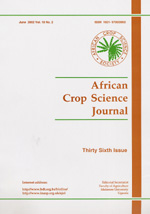
|
African Crop Science Journal
African Crop Science Society
ISSN: 1021-9730
EISSN: 1021-9730
Vol. 6, No. 2, 1998, pp. 189-195
|
 Bioline Code: cs98021
Bioline Code: cs98021
Full paper language: English
Document type: Short Communication
Document available free of charge
|
|
|
African Crop Science Journal, Vol. 6, No. 2, 1998, pp. 189-195
| en |
Effects of thinning after anthesis on groundnut growth, yield and yield components
Tarimo, A.J.P. & Blamey, F.P.C.
Abstract
This experiment was carried out to study groundnut (Arachis
hypogaea L.)
response to enhanced penetration of photosynthetically active radiation
(PAR) into the canopy
during reproductive growth in southeast Queensland, Australia. The
experiment was located at
the University of Queensland's Redland Bay Farm. Two groundnut cultivars
(Improved Virginia
Bunch and Red Spanish) were grown at a population of 42 plants
m-2) and
thinned at intensities of either 0% (control), 33%, 50%, 66% or 75% after
anthesis (42 days after
planting). The results show that thinning reduced PAR intercepted during
reproductive growth,
but slightly increased radiation use efficiency (Ec) with 33% plant removal
in Red Spanish.
Removal of either 0%, 33% or 50% of plants resulted in relatively similar
total dry mass (TDM)
and economic yields at maturity. Dry mass partitioning to reproductive
sinks was largely
unaffected by thinning after anthesis. It is concluded that removal of up
to 50% of groundnut
plants from the initial population of 42 m-2 after anthesis did
not significantly
reduce TDM or economic yield at maturity.
Keywords
Arachis hypogaea, economic yield, photosynthetically active radiation, thinning intensity, total dry mass
|
| |
| fr |
Tarimo, A.J.P. & Blamey, F.P.C.
Résumé
Cette expérimentation a été effectuée en vue
d'étudier
la réaction de l'arachide (Arachis hypogea L.) à la
pénétration intense de la radiation
photosynthétiquement active (PAR)
dans la canopie pendant la croissance reproductive au sud-est de Queensland
en Australie.
L'expérimentation a eu lieu à la ferme de Redland Bay de
l'Université de
Queensland. Deux cultivars de l'arachide (l'érigé
amélioré de
Virginie et l'Espagnol Rouge) ont poussé jusqu' à une
population de 42
plantes/m2. Ils ont été ensuité soumis au
démariage à 0% (temoin), 33%, 66% ou 75% après
l'anthèse (42
jours après le sémis). Les résultats montrent que le
démariage
reduisait le PAR intercepté pendant la croissance reproductive mais
augmentait
légèrement l'efficacité de la radiation
utilisée (Ec) avec un
démariage de 33% des plantes pour le cultivar Espagnol Rouge. Le
démariage de
0%, 33% ou 50% des plantes aboutit à une masse totale sèche
(TDM) et aux
rendements économiques assez semblables à la maturité.
La
répartition de la matière sèche dans le bloc de
stockagede la reproduction
n'était pas vraiment affectée par le démariage
après
l'anthèse. Il en résulte qu'un démariage d'un maximum
de 50% des plantes
d'arachide à partir d'une population initiale de 42/m2
après
l'anthèse ne réduitsait pas de façon significative la
mass sèche
totale (TDM) ou le rendement économique à la
maturité.
Mots Clés
Arachis hypogaea, rendement économique, radiation photosynthétiquement active, intensité de démariage, masse sèche totale
|
| |
© Copyright 1998 - African Crop Science Society
|
|
